
Cinesite Montreal received an Emmy nomination in the category of Outstanding Special Visual Effects for its fantasy environmental work on the Starz television adaption of 'American Gods'. In five of the series' episodes, their team delivered 160 VFX shots for 18 separate sequences. Created by Bryan Fuller and Michael Green, 'American Gods' is based on a novel written by Neil Gaiman in 2001, a story of a modern world on the brink of conflict between old and new deities.
Broadcast Deadlines
In his interview with Digital Media World, Cinesite's VFX supervisor Aymeric Perceval described 'American Gods' as a creative and stylistic challenge from the very start. The show's creators had pitched it as “cinematically aggressive”, and for the visual effects team at Cinesite, that description could have gone in many directions. But fortunately the show's production team simply focused on the narrative itself, which gave the artists enough scope to balance their work between realistic effects and stylistic experimentation, in line with Neil Gaiman's fantasy style.
Aymeric said, “Working on this series allowed us a lot of freedom to invent, create and interpret concepts for which there were not always specific visual references to draw from. Our shots appear in the first four episodes and the series final, covering a good range of visual effects predominantly driven by environment work.”
Like most broadcast projects, the delivery deadlines came up quite fast every week. This makes a difference when producing the stylised effects the show called for because, instead of organising them according to type or level of difficulty as on a film project, they have to be delivered in time for the episode they appear in. Consequently, Aymeric said their team decided to “go bold, have fun and focus on the story to give ourselves a chance to be creative while still keeping to schedule. The benefit of working this way brings sharpness and crispness to the process, which gave very good results. It was also very satisfying for us as teams to come up with creative responses to support the story.”
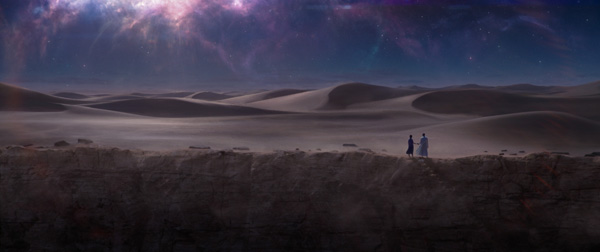

Out of this World
Kevin Tod Haug, the client VFX Supervisor, initially contacted Cinesite Montreal in early 2016 to talk about ‘out of this world’ environments and ‘epic’ set extensions for an afterlife sequence, plates for which were about to be shot in both Toronto and Oklahoma in one of the state's few true desert areas.
Very quickly, they also got involved in the look development of the storm, which became a character in itself, alongside other sequences. “We pitched mood boards, concepts and a comprehensive 2D proof of concept with rain, blowing grass and a supercell showing separate, recognizable layers and rotating elements, all based on a still photograph that one of the directors David Slade had given us,” Aymeric said.
“I purposely didn’t read the book until a few months into the project because I didn’t want my interpretation of the original material to occlude the changes the creators and David Slade were trying to add to the universe.”
Because Kevin and VFX Supervisor David Stump were handling most of the on-set supervision Aymeric's team didn’t need to go on set very often during production. However, because the shoot took place on so many different sets, Cinesite did need to support them occasionally, first in Oklahoma and then in Toronto, the main production location.
“One of our supervisors covered the desert shoot, where he captured reference imagery and set information, and we could rely on the wranglers on set for our camera information. I went to set myself later on in Toronto for a blue screen shoot where we covered all the action and angles needed for the complex introduction to episode 3,” said Aymeric.
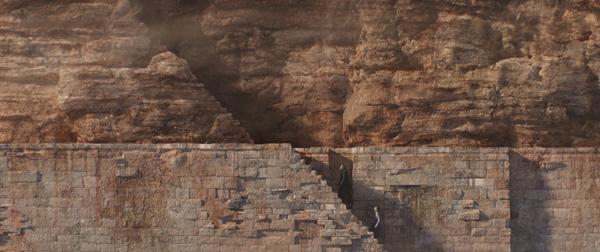
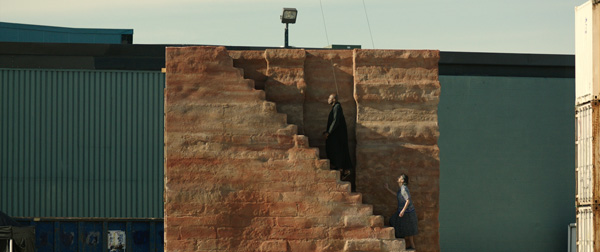
Supercell
Before diving into his explanation of that episode, however, Aymeric wanted to talk about the storm, an essential element of this season of American Gods. From the very beginning, Kevin and the show creators wanted Cinesite to give it the presence of a character who observes from a distance at first, but then follows two of the main characters Mr Wednesday and Shadow Moon on their road trip, looming over them. In the pivotal third episode, the storm finally catches up with them, breaks apart and we do not see it again until it reappears in the confrontation between the old and new gods in the series finale.
“Once the storm was awarded to us, we initially developed it as a completely 2D effect,” he said. “Our matte painting lead Philippe Langlois and his team worked out a visual means of describing exactly what makes a supercell, building up a library of flanking lines, wall clouds and anvils. the VFX team were able to find enough reference material to get started, but because such reference has to be captured at a safe distance from a real supercell, of course, we needed to interpret and adapt the angles and perspective to make the composition work within the frame.
“We also divided our matte paintings into several layers so that the compositing team could build internal movements, creating 2D and 2.5D distortion maps to fine-tune it, shot by shot. However, for the series finale, when the characters Mr World and Odin are controlling the weather, we really wanted to push the storm further in 3D. The supercell arrives fast behind the gods and ends up fully covering the sky.”
To construct this look realistically, it was useful to watch time-lapse references of clouds forming and disappearing, rolling like waves. FX artist Masaya Sugimura explained that the construction was based on a simulation in Houdini. He said, “We created a custom volume deformer on top of the simulation's layers, allowing flexible art direction of the FX and giving us enough control to adjust the effect in several shots over time, while looking out for visual inconsistencies created by the holes in the 3D noise.”

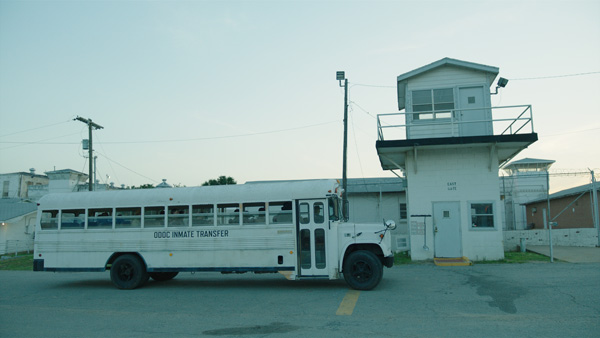
The compositors then balanced these layers to complete the animated matte painting without concealing the storm effect, and added small bolts of lightning and flashes to the final composite. This result was shared with the other vendors who were using the storm composites as a backplate. Once their overall storm set-up was in place, the team used it to deliver two complete full CG shots in which the viewer travels inside the storm clouds and discovers these intriguing movements from within.
Procedural vs Hands-on
“All of our models were built in Maya and Zbrush with textures made in Mari and Photoshop. We rendered using Arnold,” Aymeric said. “Our FX were created using a mix of Maya and Houdini. Apart from the giant multi-layered storm clouds, we designed various fun effects as well, under the supervision of our lead Alexandre Aillet, including a ceiling destruction, lightning bolts, sparks, blowing sand, falling rain, astronomical effects, flying leaves, petals and a forest of trees blowing in the wind.
“Alexandre’s philosophy was to use the best of both a procedural and a keyframe approach. The procedural approach allows straightforward updates, often without any time delay. The setups can also be easily edited and re purposed for other shots. However, it doesn't work in every situation and sometimes results in a longer development process because you need to think about everything carefully and monitor the changing point count of the data upstream. UVs can break part, if not the whole setup.
“In contrast, adopting a hands-on approach gives you better control over the changes requested in positioning, timing, look and so on, allowing you to produce exactly what you want. The drawback is having to do almost everything from scratch each time there is an upstream update. The set-ups are rarely reusable for other shots.”
In general he advised remembering that procedurally generated FX give you a good first base - providing the setup is properly created and used - that you always need to hand tweak according to shots and supervisor specifications to achieve the perfect final shot.
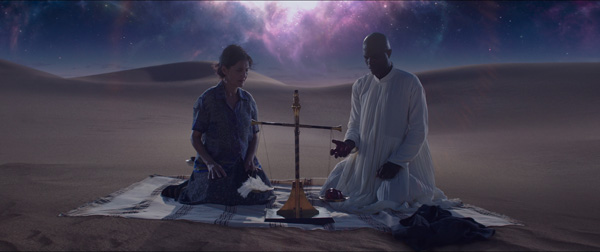

Impossible Camera Move
Episode 3 marked a critical point in the story. “The episode begins with an ‘impossible camera move’ that is typical of Kevin's style, going through five plates of apartment interiors, each representing a faith, and joined together by CG transitions. The first plate is a drone shot. Then three plates follow using a motion controlled camera that was actually set up to rotate instead of moving straight, plus one final plate for our character Mrs Fadil,” Aymeric said..
“We started by stabilizing, retiming and reanimating the cameras to give them a straight but not continuous movement. Some plates, like the first one, ended up being completely rebuilt in Nuke. For the transitions, we added a hint of CG - the skylight, the carpets and the tiles we fly through, as well as the bathroom wall the camera runs past. The only 2D transition ended up being a chicken as the camera was initially going for the ground but it was decided at the last minute to go through it.”
Aymeric's explanation shows that there was some variation in how complete and consistent the sets were, moving from studio to location and back again. In considering whether there was a 'typical' shooting scenario, he said, “I would say our sequence featuring Mrs Fadil included the most variations in terms of sets. We start in her flat, entirely built on stage, and then climb with her up various ancient types of stairs, each one based on a different set piece constructed and filmed in the studio parking lot. The final part was shot on location in Oklahoma with some partially built elements.
“For other sequences, I would say the situation was more consistent, with all interiors shot on stage with blue screens visible through the windows. Most of the exteriors, with the exception of Laura’s afterlife sequence, were shot on location.”
Afterlife
This afterlife sequence transpired into one of Cinesite's biggest challenges and most complex environments, the audience’s introduction to Egyptian God Anubis and the two variations of the afterlife created for Mrs Fadil’s and Laura’s death sequences. The two scenes were shot very differently between two locations, as mentioned above. The first was in Oklahoma's desert region, and the second was on a 12-by-20ft blue screen stage in Toronto. The VFX team's task was to combine the elements together into a “stylised fantastical desert, halfway between an earthly place and another dimension”.
Aymeric said that, although it wasn't the production's original intention, everything including the sand was replaced digitally. “The team did travel out to Oklahoma to shoot beautiful dunes under the sun, which was to be used to simulate bright constellations to which we would have added the mystical sky, the five-door duat depicting the ancient Egyptian underworld, and the cliff,” he said. “But rain hit just as we arrived, making the sand look uneven and far from what the producers had in mind.”
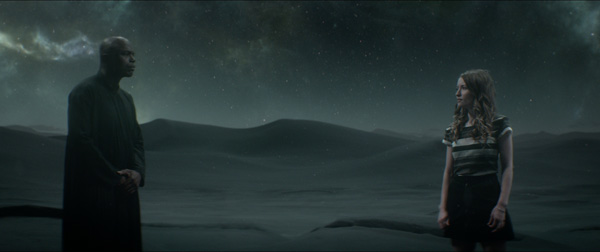
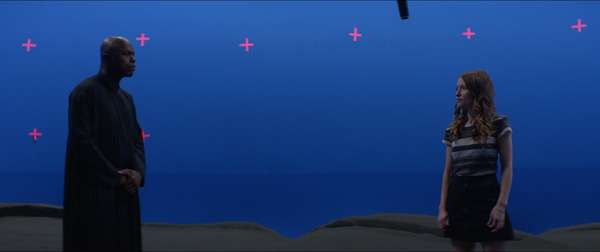
Due to their restricted schedule the crew couldn’t wait, resulting in lots of footprints and tyre marks. Cinesite began by replacing the sand dunes for a smooth, pristine surface, topped with blowing FX sand passes to give the shots a bit more life, with other passes and 2D elements to avoid too earthlike an appearance. Different colour palettes were developed to give Laura’s death a toxic, unsettling quality and Mrs Fadil’s a peaceful feeling.
“For the sky, we played in compositing with multiple layers of constellations and stars to add depth to the scene, using space and long exposure night photography as reference. Finally, the duat was entirely reconstructed in CG based on a partial set piece shot on location,” Aymeric said.
“Despite the extra work, I’m happy they shot on location because it allowed David Slade to play properly with the light and capture a level of photographic input that you can't always achieve with a blue screen. It also helped us understand his intention for each shot.”
Unseasonal
The environmental manipulation Cinesite created for the series' final episode was pure fantasy, in which a woman representing Easter absorbs spring and returns the world to winter – but without letting the scene's forest first go through summer growth and autumnal recession. Cinesite’s team digitally created the untimely leaf transformation and weather system. When Easter raises her arms, opens the skies and makes the wind blow, hundreds of petals start to revolve around her and as her power builds, the camera pulls back and up to reveal the rural landscape returning to its winter state.
Aymeric said, “That rising camera move is the most complex shot we created for the series. A few array plates had been captured with a Red camera attached to a drone to provide information for our tracking/layout lead Mehdi Tadlaoui to recreate the actual topography around the house and give the required movement, speed and framing. Then the hard work started! From the trees in the woods to the flowers around the house, all of the lush vegetation had to go and we knew the parallax would not allow us to take shortcuts.”
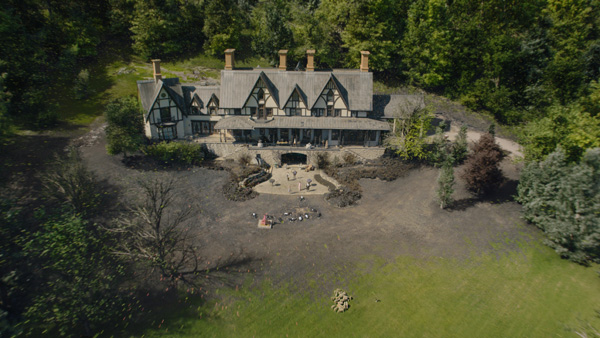
Springtime.
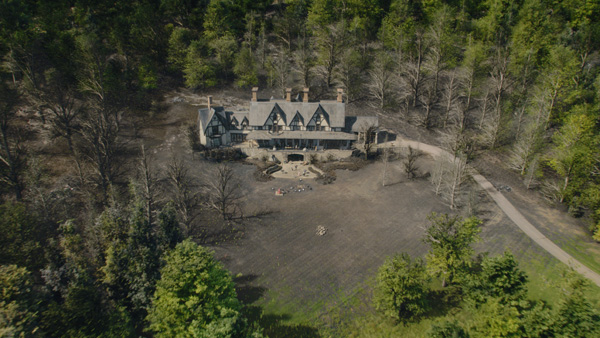
Winter.
The low, scattered vegetation could support a 2D approach but the trees had to rely on CG. Matte painting artist JaeHee Jung began by recreating multiple tiles of open ground, leaving only dirt and low grass that would later be withered by grading in compositing. During that time, they progressed with Speedtree and generated six types of trees with five different shape variations each, and laid out over 2,000 of them.
Clever Cache
Eric Senecal, the layout/FX artist on the sequence, remarked, “A key reason that we were able to generate and work in Maya with that number of polygons was due to Cinesite’s in house Meshcache /particleProxy object. It allowed us to keep millions of polygons in our scene and still work with all of that information in the viewport. We also used a visual trick in the shot - the further away the trees were from the camera path, the greater the reduction in the number of leaves and scaling of the leaf instances.
“We streamlined the process even further by only adding the wind to the foreground trees, leaving the background trees static. The branches and trunks were imported into Maya, while only the leaf points were imported into Houdini for the simulation. Once the points cache was brought back into Maya, we had all the information needed to shrink them down and move them with the wind.”
In this way, they achieved an efficient broadcast turnover of six hours and, consequently, enough time to run several tests on how to best convey the story point of the shot. After all, the effort would have been futile if the trees had appeared too stylized. To prevent this, lighting lead Mark Stepanek set up a camera projection technique combining the 3D render with the original plate, resulting in a photoreal transition. With this technique, Mark managed to retain crucial detail that is hard to achieve in 3D and also allowed the compositors more time for the integration of the renders - not on the specifics of the renders themselves. www.cinesite.com



















